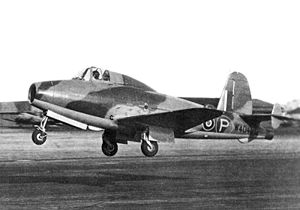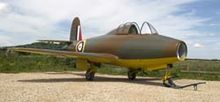Gloster E.28/39 Video - Wings of Russia - Fighters - The Jet Era
|
|
Gloster E.28/39

Picture - The first E.28/39 prototype W4041/G
Role: Experimental prototype
Manufacturer: Gloster Aircraft Company
Designed by: George Carter
First flight: 15 May 1941
Primary user: Royal Aircraft Establishment
Number built: 2 prototypes
The Gloster E.28/39, (also referred to as the "Gloster Whittle", "Gloster Pioneer", or "Gloster G.40") was the first British jet engined aircraft to fly. Developed to test the new Whittle jet engine in flight, the test results would influence the development of an operational fighter, the Gloster Meteor.
Design and development
In September 1939, the Air Ministry issued a specification to Gloster for an aircraft to test one of Frank Whittle's turbojet designs in flight. The E.28/39 name comes from the aircraft having been built to the 28th "Experimental" specification issued by the Air Ministry in 1939. The E.28/39 specification had actually required the aircraft to carry two .303 Browning machine guns in each wing, but these were never fitted.
Working closely with Whittle, Gloster's chief designer George Carter laid out a small low-wing aircraft of conventional configuration. The jet intake was in the nose, and the tail-fin and elevators were mounted above the jet-pipe. A contract for two prototypes was signed by the Air Ministry on 3 February 1940 and the first of these was completed by April 1941. Manufacturing started in Hucclecote near Gloucester, but was later moved to Regent Motors in Cheltenham High St (now the Regent Arcade), considered a location safer from bombing.
Testing
Although the initial flight tests were seemingly early in the Second World War, the Germans were one stage ahead, having first tested their Heinkel He 178 at 6 am on 27 August 1939, days before the start of the war itself at Rostock-Marienehe on the Baltic Coast, piloted by Erich Warsitz.
Picture - Statue in Coventry, England of Sir Frank Whittle observing the first jet powered flight
Picture - Plaque on base of the statue of Frank Whittle in Coventry, England
The aircraft was delivered to Brockworth for ground tests beginning on 7 April 1941 using a non-flightworthy version of the Power Jets W.1 engine. These include some short "hops" of about 6 ft in height from Brockworth's grass airfield. With these initial tests satisfactorily completed, the aircraft was fitted with the flightworthy new engine rated for 10 hours use and transferred to Cranwell which had a long runway. On 15 May 1941, Gloster's Chief Test Pilot, Flight Lieutenant Gerry Sayer flew the aircraft under jet power for the first time from RAF Cranwell, near Sleaford in Lincolnshire. The flight lasted 17 minutes and was a complete success.
Tests continued with increasingly refined versions of the engine over the following months. Later in the test program, small, auxiliary fins were added near the tips of the tailplanes to provide additional stability in high-speed flight.
Chief Test Pilot Sayer disappeared during an acceptance test flight for a Hawker Typhoon, presumably killed, and his assistant took over. The oil system had been changed before he flew and after it was proven the aircraft was handed over to the RAE and flying by service pilots.
The second prototype (Serial W4046) joined the test programme on 1 March 1943, initially powered by a Rover W2B engine. Testing had revealed problems with engine oil and lubricants. Flying of W4046 was by John Grierson and John Crosby Warren, (also Gloster pilots) as Michael Daunt was now involved with the F.9/40. In April, W4046 flew to Hatfield for a demonstration before the Prime Minister and members of the Air Staff. It was taken to Farnborough and fitted with a 1,500 lbf (6.7 kN) W2.B. It achieved 466 mph. This prototype was destroyed on 30 July while on a high altitude test flight in a crash resulting from an aileron failure, attributed to the use of the wrong type of grease in the aileron controls. One aileron had "stuck in position, sending the aircraft out of control" . The test pilot successfully bailed out from 33,000 ft.
The first prototype was fitted with the 1,700 lbf (7.6 kN) thrust W2/500. It was flown successfully to 42,000 ft but level speed at altitude was not attempted due to fuel shortage. The pilot commented in his report on a need for cockpit heating and a larger fuel tank.
The first prototype continued flight tests until 1944. By that time, more advanced turbojet-powered aircraft were available. Although the Gloster E.28/39 was not able to achieve high speeds, it proved to be a capable experimental platform and exhibited a "good climb rate and ceiling" . Moreover, experience with the E.28/39 paved the way for Britain's first operational jet fighter aircraft, the Gloster Meteor. This featured the Rolls-Royce Welland engine, the next stage from the Power Jets W.1.
Survivors
In 1946, the first prototype (serial W4041) was placed in the Science Museum in Central London, where it is still exhibited. A full-size replica has been placed on an obelisk on a roundabout near the northern perimeter of Farnborough Airfield in Hampshire as a memorial to Sir Frank Whittle. A similar full-size model is on display in the middle of a roundabout at Lutterworth in Leicestershire (pictured below) where the aircraft's engine was produced.
A full-scale model taken from the same moulds, with authentic paint scheme and detailing, has been built by members of the Jet Age Museum in Gloucester. It has recently been on display in Brockworth, Gloucester, at the Kemble Air Day and MVT Show also at Kemble, and formed part of the display for the Sir Frank Whittle Centenary commemorations at RAF Cranwell in June 2007.

Picture - Jet Age Museum’s E28
Operators
United Kingdom
Royal Aircraft Establishment
Specifications (Gloster E.28/39)

Picture - Replica of the Gloster E.28/39 at Lutterworth
Data from
General characteristics
Crew: One
Length: 25 ft 4 in (7.74 m)
Wingspan: 29 ft 0 in (8.84 m)
Height: 8 ft 10 in (2.70 m)
Wing area: 146 ft² (13.6 m²)
Airfoil: G.W.2-section
Empty weight: 2,886 lb (1,309 kg)
Loaded weight: 3,748 lb (1,700 kg)
Powerplant: 1x— Power Jets W.1 turbojet, 860 lbf (3.8 kN)
Fuel capacity: 81 gallons
Performance
Maximum speed: 338 mph (544 km/h) at 10,000 ft (3,050 m)
Range: 410 mi (656 km)
Endurance: 56 minutes
Service ceiling: 32,000 ft (9,755 m)
Rate of climb: 1,063 ft/min (5.9 m/s)
Thrust/weight: 0.21
Armament
Guns: None fitted but provision for four 0.303 in (7.7 mm) Browning machine guns
Heinkel He 178 - world's first turbojet aircraft.
Heinkel He 280 - first turbojet-powered fighter design
Messerschmitt Me 262 - world's first operational jet fighter.
Gloster Meteor - first British jet fighter to see combat in the Second World War.
Bell P-59A - first US jet fighter design
P-80 Shooting Star - first US operational jet-fighter aircraft.
Gloster E.1/44 - Gloster's third jet design to fly
Bibliography
James, Derek N. Gloster Aircraft since 1917. London: Putnam, 1987. ISBN 0-85177-807-0.
Mondey, David. The Hamlyn Concise Guide to British Aircraft of World War II. London: Chancellor Press, 1994. ISBN 1-85152-668-4.
Morgan, Eric B. "A New Concept of Flight" Twentyfirst Profile Vol. 1, no.8. New Milton, Hantfordshire, UK: 21st Profile Ltd. ISBN 0-961-8120-04.
"No Airscrew Necessary..." Flight(flightglobal.com), 27 October 1949.
Swanborough, Gordon. British Aircraft at War, 1939-1945. East Sussex, UK: HPC Publishing, 1997. ISBN 0-9531421-0-8.
Winchester, Jim. X-Planes and Prototypes. London: Amber Books Ltd., 2005. ISBN 1-904687-40-7.
Living Warbirds: The best warbirds DVD series.
Source: WikiPedia